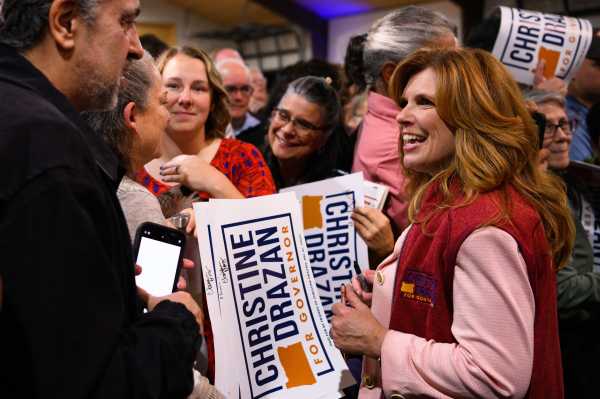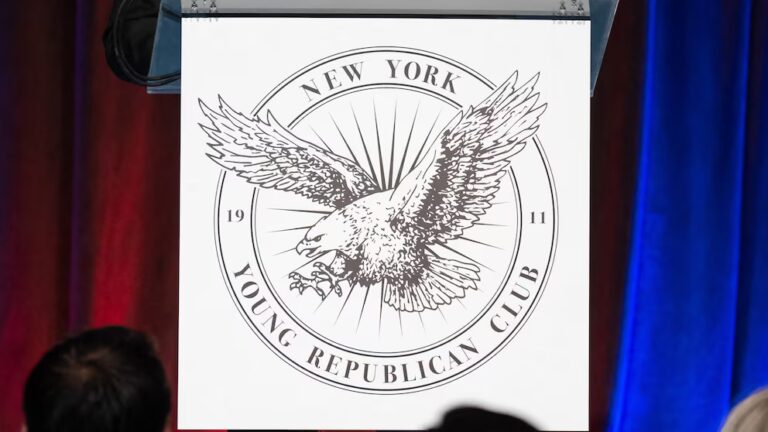
Part of The 2022 midterm elections, explained
Oregon is a reliably blue state that hasn’t elected a Republican governor since 1982. But due to a divided field — and frustration with the sitting governor — this cycle, Republicans just might eke out a victory.
On its surface, the Oregon governor’s race seems like a cookie-cutter iteration of Republicans’ midterms strategy. Like other GOP candidates across the country, Republican Christine Drazan has attacked her opponent, Democrat Tina Kotek, over the economy and crime, and tied her to sitting Gov. Kate Brown’s performance, which polls poorly.
But this cycle isn’t just about backlash to the ruling party in Oregon, or fears about crime and the economy. The unusual nature of the race — which has seen unaffiliated candidate Betsy Johnson attract around 14 percent in polling — is also the culmination of a years-long campaign by a small number of special interests seeking to control the state.
At the root of that campaign is the state’s partisan divide over climate action. For years, the state has struggled with a conservative minority that has successfully stalled cap-and-trade and conservation policies. Oregon has become a hotbed for alt-right extremists who have set the stage for the election, including one pro-logging grassroots group, Timber Unity, whose leaders have been linked to alt-right militias.
Perhaps most significantly, the state’s richest man, Nike co-founder Phil Knight, could tip the scales toward Drazan. Despite fashioning himself (and the company) as a climate champion, he’s funneled millions to Johnson and Drazan.
Timber Unity’s influence and Knight’s donations may be just what’s needed to put a Republican in office. And if Drazan wins, Oregon would become the first state in the West to reverse course on its climate goals.
“Who’s in the governor’s office is really the person who gets to flip the switch off on all of our climate action,” said Steve Pedery of the Oregon Wildlife Conservation Leaders Fund, an environmental PAC.
In October’s polling, according to FiveThirtyEight’s calculations, Drazan and Kotek are virtually tied. That suggests Drazan could win. If she does, Pedery said such a win could become a model for Republicans in other traditionally blue states.
“If this works in Oregon, it can be replicated,” he said.
Recent battles over climate presaged a tumultuous governor’s race
Oregon is known nationally for being solidly blue, but its internal politics are more nuanced. The biggest source of friction is in the state’s environmental politics, because outside blue Portland, the eastern area of the state is home to both old-growth forests and a large logging industry.
“Timber is to Oregon what coal is to West Virginia,” Pedery said. “There’s legacy logging money that funds all of our right-wing causes in the state.”
The timber industry’s power makes for more unusual politics than the typical left-right divide on climate change. You can find plenty of Democrats who, like Sen. Joe Manchin in West Virginia, are supported by an industry that opposes climate change policies.
One of these politicians is Johnson, an independent who voted repeatedly against climate bills when she was a Democrat in the state chamber. She’s what environmentalists in the state call a “timbercrat,” a close ally of the logging industry and herself a beneficiary of a logging family fortune.
The timber-Democratic alliance goes back decades. But a growing number of political extremists in timber-rich areas and an increasingly powerful right-wing PAC that presents itself as the voice of Oregonians connected to logging, trucking, and farming, Timber Unity, have changed longstanding dynamics.
In 2019, with the vocal support of the newly formed Timber Unity, 11 Republican lawmakers left the state capitol to avoid a vote on a cap-and-trade bill — just enough of them to stall the vote. The walkout ended messily: Democratic Gov. Brown sent state troopers, demanding the Republicans “return and do the jobs they were elected to do.” When the vote finally occurred, the bill failed by one vote (three Senate Democrats, including Johnson, voted against it).
When Democrats tried again to pass climate legislation in 2020, Republicans used the same playbook, this time led by Drazan, a newcomer to the state legislature. Kotek, then speaker of the House, tried to usher through the climate bills. Johnson provided the key vote that killed the cap-and-trade legislation when it finally came to a vote in 2019 (it never came to a vote in 2020).
Timber Unity played a key role in all the chaos, egging on opposition to the bill and the GOP’s walkouts. Timber Unity by then had grown quickly to become a legitimized power broker in the state, despite the group founders’ ties to white nationalist militia interests. Its influence helped rally truck drivers at the state capitol in support of the walkouts, and its reach helped create the impression that the GOP’s oppositional tactics represented the will of a large swath of Oregon residents.
As a result of these ultimately successful walkouts, Drazan’s profile rose while Oregon missed its window to pass climate legislation in 2020, again.
How fallout from the walkouts is shaping the gubernatorial race
Each candidate’s climate platform is a logical extension of their role in the walkouts: Kotek promises to continue developing the state’s climate goals; Drazan argues such policies are a drag on the state economy and the limited measures the current governor instituted via executive action should be reversed; Johnson pledges to revoke the governor’s cap-and-trade policies if elected, too.
Johnson trails far behind both Kotek and Drazan in polling. She’s endured in the race this long because she is also the best-funded candidate, thanks to the state’s richest man, Knight, the co-founder and chair emeritus of footwear giant Nike.
He has single-handedly flooded Johnson’s campaign with $3.75 million in cash, and another $2 million to a PAC dedicated to electing more Republicans to the Oregon legislature. In October, he contributed his first $1 million to Drazan’s campaign.
A third candidate’s presence, boosted by Knight’s cash, has upended all normal expectations for the race. In a “normal” cycle, John Horvick, senior vice president of the Pacific Northwest research firm DHM Research, said that “Democrats probably have about a 5 percentage point advantage over Republicans and gubernatorial elections.”
Political strategists note that, as Johnson is a former Democrat, her candidacy is pulling away support that might otherwise go to Kotek. “There’s a real attempt to stop Democrats from defecting to Johnson,” said Horvick. If Kotek loses, it could be Knight’s money that’s to blame.
Some progressive advocates claim Johnson is a poison pill, set up by bigger fish to pull support away from Kotek. Recently, Timber Unity alluded to that exact strategy on Facebook: “God Bless Betsy Johnson! Now for the LOVE OF GOD, can we just all stick together this ONE TIME and Vote DRAZAN!!!!!”
If Johnson’s presence does manage to tip the race to the Republican, the use of a third candidate to siphon off Democratic support could become a model in reliably blue states to reverse climate action. All Republicans would need is a deep-pocketed backer and a viable moderate or conservative Democrat.
The result of the 2022 gubernatorial race will have a major impact on regional climate policy
Beyond political considerations, a Kotek loss would also have major ramifications for West Coast climate policy. Because of the walkouts, Oregon’s most ambitious policy was put in place by a 2020 executive order that set a benchmark for cutting the state’s greenhouse gas emissions at least 45 percent below 1990 levels within 15 years; it also requires state agencies to come up with plans that reduce transportation and power emissions, and ensure forests store more carbon.
Drazan has said reversing Brown’s executive orders is her day-one priority. Should she do so, the biggest and most permanent damage would be allowing unchecked deforestation in favor of agriculture and logging. Oregon is a relatively small economy compared to its neighbors, but considering its forests, its biggest impact on the climate is in land use and carbon sequestration.
Oregon and its bigger neighbors, Washington and California, have often worked in concert in updating its environmental rules. When California banned hydrofluorocarbons used in air conditioning, Oregon did, too. Going forward, the states will need to work together to expand transmission of renewable energy projects, as they receive federal funds from the Inflation Reduction Act.
Oregon could become a major obstacle to expanding renewables across the coast, if Drazan appoints pro-gas utility regulators to the state commission. And some conservationists, like Doug Moore, executive director of the Oregon League of Conservation Voters, fear Oregon could becoming a dumping ground for goods like inefficient cars that can’t be sold in California or Washington.
Climate advocates worry the election is about to undo over a decade of campaigning to move Oregon forward on climate action. This shift wouldn’t be accidental, but the result of methodical, well-funded efforts to give anti-climate candidates a real foothold.
And the stakes for both democracy and climate policy are high. “Oregon has been driving a national conversation on climate for quite a while,” Moore said. “With one stroke of a pen, Christine Drazan could unwind all.”
Will you support Vox’s explanatory journalism?
Millions turn to Vox to understand what’s happening in the news. Our mission has never been more vital than it is in this moment: to empower through understanding. Financial contributions from our readers are a critical part of supporting our resource-intensive work and help us keep our journalism free for all. Please consider making a contribution to Vox today.
Sourse: vox.com






